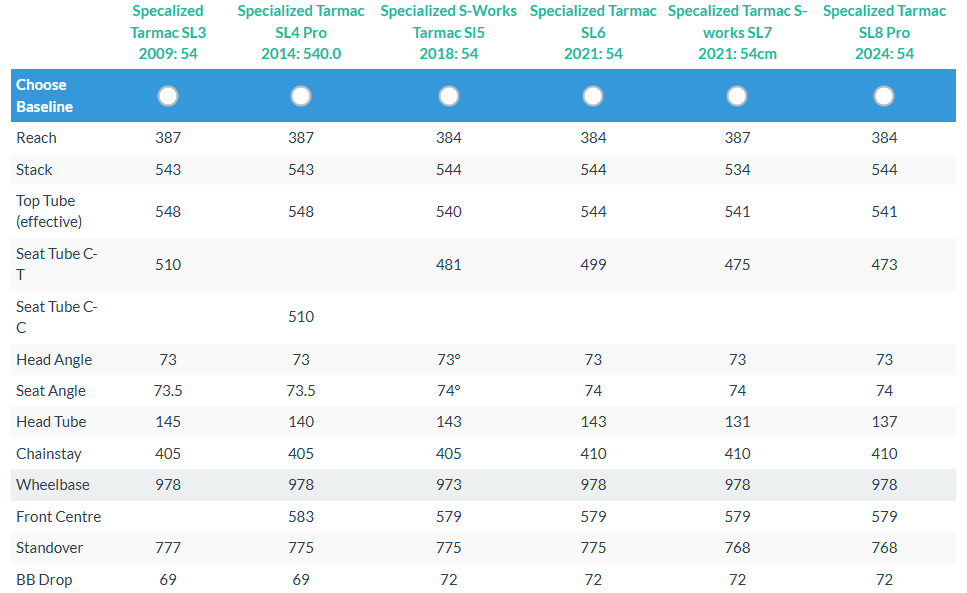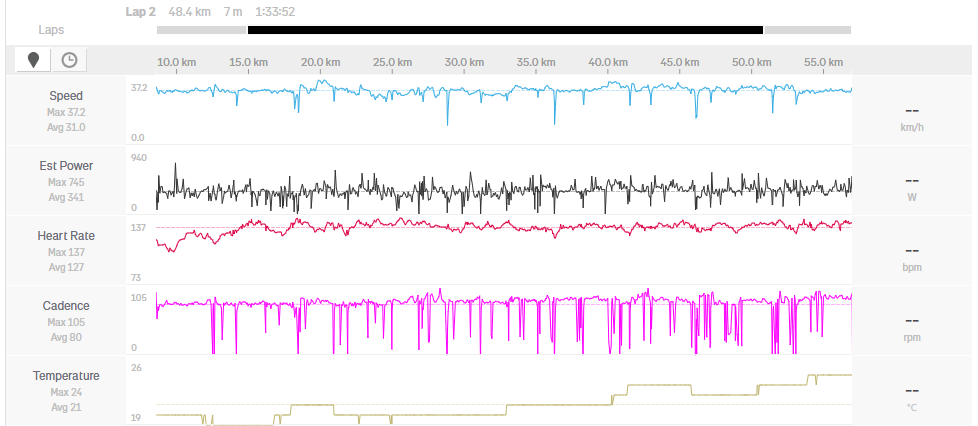-
Postów
15 033 -
Dołączył
-
Ostatnia wizyta
Treść opublikowana przez jajacek
-
@Veriv Ja tak ogólnie o jakości. Natomiast być może do fulli ma się to nijak.
-
Co do łożysk to ostatnio kupujemy właśnie Enduro Max po 20 zł czyli 5 Euro. I konsekwentnie wymieniamy te gorsze na Enduro. Co do jakości to widzę, że mógłbyś się posprzeczać z moim kolegą mechanikiem ale pewnie byście się w wielu kwestiach zgodzili. U niego gradacja jest z grubsza Spec, Scott, Cannodale, Cervelo, Santa. Pinarello, gzie rama kosztowała 28 tys zł składał w zeszłym roku i mi pisał, że jest zniesmaczony tym jak rama wygląda w środku. Canyon i Trek były u niego niemal na końcu listy. Natomiast Raoul Luescher, który prowadzi na YT kanał Luescher Teknik, i który tnie w poprzek ramy szosowe, wyrażał się ostatnio bardzo pozytywnie o Cube. Być może jest to efektem współpracy Cube z zespołem World Tour. Natomiast na jego kanale też widać jak dużej poprawie uległy ramy na przestrzeni lat. Pamiętam że o jakiejś ramie Speca pisał ze 2-3 lat temu jako o najlepszej jakości jakiej kiedykolwiek widział w ten branży. A jest to inżynier, który pracował dla Boeinga. Co ciekawe Spec przenosi swoje R&D w dużym stopniu do Niemiec. Obecnie ramy karbonowe projektuje dla niego Denk Engineering z Freiburga. Dziś się zorientowałem że Spec otworzył w DE fabrykę opon: I went inside Specialized's tyre factory to see how prototypes for the pros are made in less than 48 hours | BikeRadar A wiem że wiele poprzednich modeli było produkowane przez Vittorię w Tajlandii. Ramy karbonowe Speca od 15-20 lat produkuje fabryka Topkey na Tajwanie. Kolega mechanik wyrażał się też bardzo dobrze o jakości Fuji. Tu mam doświadczenia tylko z ramą torową którą mieliśmy i była super. Dwóch kolegów miało szosy i też bardzo chwalili. Ale to bardzo mała grupa porównawcza. Natomiast ram torowych Fuji w polskich kolarstwie jest zatrzęsienie i cieszą się bardzo dobrą opinią. Bardzo też chwalił czeskiego Superiora. Inny kumpel mechanik bardzo dobrze wyrażał się o niemieckich Focusach. Składałem jedną przełajówkę kumplowi i była to zajebista rama. Mój młody ścigał się na szwajcarsko-niemiecko-tajwańskim ARC8 Escapee DB i to też były dobre ramy. Przeżyły wszystkie gleby.
-

Szosa w budżecie ok. 3.5k zł
jajacek odpowiedział(a) na Pilszu temat w Jaki rower kupić do X złotych?
Wszystko zależy od jakości wykonania i wagi ramy. Starsze ramy zwykle więcej ważyły więc były wytrzymalsze. Jak pojawiły się hamulce tarczowe i koła tubeless to zaczęto cieniować ramy i widelce. Wiadomo chyba z jakim skutkiem? Przykład geometrii szosy Specialized Tarmac na przestrzeni 16 lat. Roubaix tak się nie da porównać. Ponieważ wstawiono amortyzator i zmieniono wiele parametrów. Obecnie jest to rower na pograniczu endurance i gravela. -
Mamy tu kolegę, mechanika na forum, który pracuje w Niemczech i może napisze swoją ocenę. @mike21
-

Uniwersalny kompan do 3000 zł.
jajacek odpowiedział(a) na CriseQ temat w Jaki rower kupić do X złotych?
Trzeba sobie zrobić zestawienie. Ewentualnie je tu opublikować 🙂 -
Veriv pisał że sądzi że jak inna niemiecka firma rowerowa YT Industries ma problemy to ten też może mieć, skoro robi takie duże przeceny (???). Taki był sens jego wynurzeń na ten temat. Firma istnieje od jakichś 20 lat i nic nie wskazuje na jej jakiekolwiek problemy. Radon jest marką własną sklepu Bike Discount jeśli się nie mylę.
-

Uniwersalny kompan do 3000 zł.
jajacek odpowiedział(a) na CriseQ temat w Jaki rower kupić do X złotych?
Zupełnie nie śledzę tego typu rowerów. Swój sprzedałem i nie zamierzam mieć. Moim zdaniem jeśli masz MTB z napędem 1x lub 2x to robi to samo co cross ale jeszcze dodatkowo jest znacznie lepszy w terenie. W tym budżecie masz Torpado Storm X7 i X8 w Media Expert. Bije na głowę wszystkie crossy. -

Uniwersalny kompan do 3000 zł.
jajacek odpowiedział(a) na CriseQ temat w Jaki rower kupić do X złotych?
Atrapa amortyzatora, atrapa hamulców. Taki rower do sklepu po bułki, do miasta i do parku. Realna wartość jakieś 1000 zł jak dla mnie. -

Uniwersalny kompan do 3000 zł.
jajacek odpowiedział(a) na CriseQ temat w Jaki rower kupić do X złotych?
Link? -
CN-HG93 też często używałem. W MTB na 11-rzędowym 105/SLX po 1500 km był już raczej szrotem. Teraz założyłem CN-GH701-11. Zobaczymy ile pociągnie.
-

Uniwersalny kompan do 3000 zł.
jajacek odpowiedział(a) na CriseQ temat w Jaki rower kupić do X złotych?
Opony jakies 42 mm od gravela. Ja uzytkuje Specialized Pathfinder i Trigger -
Ultegry niewiele droższy chyba. A jego nowa wersja ma rzekomo 50% większą żywotność jak twierdzi Shimano. Najlepszy łańcuch do napędów 8-9 rzędów to Campagnolo Record C9. Wytrzymywał u mnie przy Deore 3x9 ok. 12 tys km.
-
To też prawda. Ostatni raz łańcuch Deore miałem ze 20 lat temu. HG40 to Alivio. Chyba w żuciu takiego nie miałem. Może w rowerze dziecięcym.
-
Trochę nie do końca. Jak zacznie przeskakiwać to zwykle masz już albo kasetę albo blat do wymiany. Możesz oczywiście jeździć na zajeżdżenie. Ale jak nie, to łańcuch powinno się wymieniać, kiedy osiągnie już odpowiednie wyciągnięcie.
-
Cena jak na karbonowy rower bardzo przyzwoita IMO. Moja używany hardtail MTB kupiony za 6500, po przeróbkach wyszedł 9k. Takich rowerów się pod sklepem nie zostawia. Po bułki to jeździmy na przełajówce kupionej za 1300 🙂
-
Ale co to za napęd? 1x czy 2x?
-

Uniwersalny kompan do 3000 zł.
jajacek odpowiedział(a) na CriseQ temat w Jaki rower kupić do X złotych?
Wystarczy chyba Street View odpalić 🙂 -

Rower dla napalonego 38letniego amatora
jajacek odpowiedział(a) na maciejc temat w Jaki rower kupić do X złotych?
@liftlodz I tak i nie. Najważniejsze jest to co napisałeś w drugim zdaniu. Jak chcesz, żeby karbon nie pękał, nie kupuj najlżejsze ramy. Natomiast co do pierwszego mógłbym to zrobić wywód na kilka stron. Ale chyba nie o to chodzi. Ramy karbonowe są produkowane w przeróżnych miejscach łącznie z Polską. Karbon czyli włókno węglowe jest niejednorodnym laminatem składającym się z wielu części. Może być zbudowane z tzw. prepegów czyli bel karbonu o różnej jakości i różnych właściwościach. A potem wypalany w całości lub w częściach. Więc po pierwsze nie jest tak że większość ram jest z Chin ale rzeczywiście większość pochodzi z ich okolic. Natomiast różnią się jakością i co bardzo ważne WŁAŚCIWOŚCIAMI. Doświadczony producent wiem jak zbudować ramę, która będzie komfortowa a jak żeby była super sztywna i aerodynamiczna. I taki projekt potrafi go kosztować bardzo dużo czasu, bardzo dużo zasobów ludzkich i technicznych. Dla przykładu rama Speca SL6 od projektu do masowej produkcji zajęła 3 lata. Została zaprojektowana przez Niemców za pomocą modeli komputerowych. Następnie wykonano dziesiątki prototypów, które testowano w tunelu aero Speca w USA. A potem dano je zawodnikom testowym, takim jak Mistrz Świata Peter Sagan czy inny Mistrz Świata Julian Alaphilippe. Feedback od nich, poprawki i końcowa produkcja w fabryce Topkey na Tajwanie. Rama składa się z ok. 500 pojedynczych części i jest robiona ręcznie. A Chińczycy z grubsza skopiowali te kształty, coś tam włożyli do formy do wypalania karbonu (nigdy nie wiesz co) i albo sprzedają na Ali Express przez pośredników, którzy twierdzą, ze sami te ramy produkują albo hurtowo innym firmom jak nasz Romet, Kross czy słowacki Kellys, które nakleją na to swoje logo. Możesz obecnie kupić gravela na tej samej ramie z tych trzech firm i jeszcze paru innych, pochodzącego z fabryki Flybike. Natomiast powstaje pytanie czy amator odczuje tu jakąś różnicę? Weekendowy amator raczej nie. Ktoś kto długo jeździ i miał wiele rowerów tak. -

Rower dla napalonego 38letniego amatora
jajacek odpowiedział(a) na maciejc temat w Jaki rower kupić do X złotych?
W dwoch Endurace znajomym pekly tylne widelki na prostej drodze, po najechaniu na studzienke. Ale to jakis czas temu. Jeden z tych co mu pekly widelki wazy stowe. I tak samo mu pekly widelki w gravelu Canyona. Natomiast co do Exceed to napatoczylem sie ostatnio na goscia co sie sciga, 75 kg. Rama mu pekla momentem. Canyon zaproponowal ciezsza wersje tej samej ramy i sie zgodzil. Ale to jest chamowa. Bo zaplacil drozej za te wycieniowana. -

Rower dla napalonego 38letniego amatora
jajacek odpowiedział(a) na maciejc temat w Jaki rower kupić do X złotych?
Ramy karbonowe Orbea znane są niestety z pękliwości. Natomiast przypuszczam, że problem jest podobny jak w Canyonie czy w Treku, które też są z tego znane. Czyli dotyczy ram dla zawodowców, ekstremalnie wycieniowanych. Mój syn w tym roku ściga się na Orbea Orca M20iTeam, podobnie jak cały jego zespół i jeszcze żadna w tym roku nie pękła. Ale to jest cięższa wersja ramy ważąca jeśli dobrze pamiętam ponad 1000 gramów. Mój kolega z kolei wycofał się ze sprzedaży rowerów Orbea w ogóle ze względu na spychologię pod względem reklamacji gwarancyjnych pękniętych ram. Zbyt dużo było z tym problemów i zbyt długo to trwało. To jest hiszpańska firma i załatwia sprawy po hiszpańsku. Czyli mañana a wiec jutro albo mañana de mañana co znaczy pojutrze a faktycznie znaczy nigdy. Co do sprzętu to też szybko jeździłem będąc znacznie młodszym i robiliśmy z kumplem średnie 30 na rowerach MTB Wheeler na kołach 26 cali z napędem 3x8 Shimano STX i sztywnym widelcem (bo nie było jeszcze amortyzatorów), mając niecałe 30 lat 🙂 Natomiast jaka jest różnica między dobrym a kiepskim rowerem to widać na tych śmiesznych filmikach: Cheap Bike Vs.Super (151) $150 Bike Vs $1,500 Bike Vs $15,000 Bike - YouTube (151) Super Bike Vs. Mid-Range Bike | What Really Is The Difference? - YouTube -

Szosa w budżecie ok. 3.5k zł
jajacek odpowiedział(a) na Pilszu temat w Jaki rower kupić do X złotych?
Jak Ci się podoba to kup to co Ci wpadło w oko. Przed chwilą z koleżanką rozmawiałem, która się przejechała do Gorzowa żeby kupić ostatniego niewymarłego Bianchi na hamulcach obręczowych i jest nim zachwycona 🙂 Jak przyjedziesz na innym rowerze to z ustawki Cię nie wyrzucimy 🙂 -

Szosa w budżecie ok. 3.5k zł
jajacek odpowiedział(a) na Pilszu temat w Jaki rower kupić do X złotych?
Co jest w tym wszystkim ważne to żeby utrzymanie roweru nie było drogie. Żeby wszystko sprawnie pracowało i żeby był relatywny komfort. Za komfort odpowiada dobrze wykonana rama i stosunkowo szerokie opony. Do Roubaix SL3 i SL4 wchodzą maks 30 mm. Te rowery, które podlinkowałeś nie są złe. Rozmiarówka Meridy jest niestandardowa i jest zaniżona. Mój młody który ma 183 wzrostu jeździł na Reacto w rozmiarze M albo S/M. Jakoś tak. Ale ta Scultura to szosa race. Kolega ma taką. Jak bym namawiał zdecydowanie na szosę typu endurance. Czyli Specialized Roubaix, Trek Domane, Giant Defy, Canyon Endurace. I tego typu. Testowałem podobną Emondę ale na tarczach. Komfort był rozsądny. Geometria pomiędzy race i endurance. Ale jeśli to ta co ma suport typu PressFit to nasz kolega mechanik radzi nie dotykać. To BMC Granfondo wygląda z sensem. Jest to rower typu endurance. -

Szosa w budżecie ok. 3.5k zł
jajacek odpowiedział(a) na Pilszu temat w Jaki rower kupić do X złotych?
A czy da się szybko na tym jeździć? To tu jest odpowiedź z dzisiaj z jazdy we dwóch. Średnia wieku 60 lat 🙂 -

Szosa w budżecie ok. 3.5k zł
jajacek odpowiedział(a) na Pilszu temat w Jaki rower kupić do X złotych?
Ja bym kupił to na czym my jeździmy. Czyli karbonowy Specialized Roubaix z hamulcami obręczowymi. Kolega swego czas dał 3500 za Roubaix na Tiagrze. To ten pierwszy rower po lewej. Może nawet na 105 znajdziesz jak dobrze poszukasz. No i możesz wtedy dołączyć do naszych Roubaix-ustawek z Bemowa. Zapewniam, że dobrze skonfigurowane hamulce są aż nadto dobre na Mazowsze. Ostatnio glebę zaliczyłem bo mam za mocne z tyłu, dałem za ostro po heblach i wpadłem w poślizg. Co do rozmiaru to jesteś pomiędzy 56 i 58. W zależności od proporcji ciała. 3 Fundamentals of Correct Bike Size - Specialized Roubaix – Livelo Bike Rental -
A Radon chyba kiedyś wklejałem że zakończył plusowym zyskiem operacyjnym.




